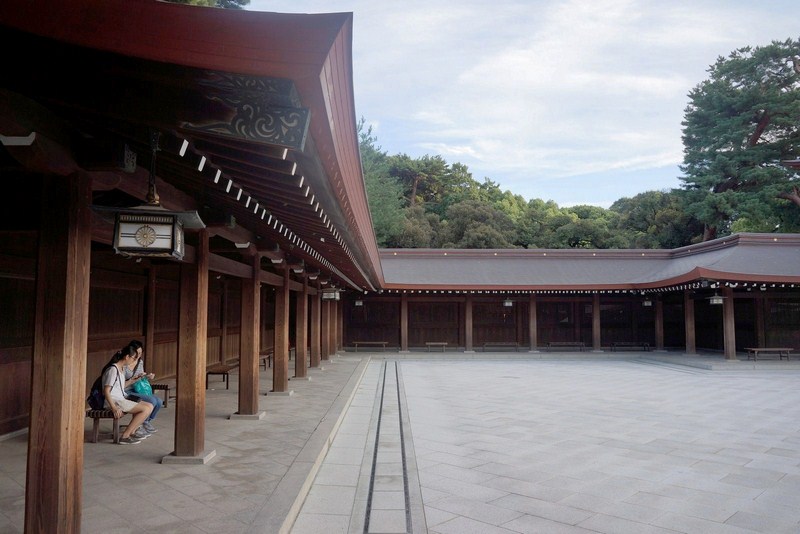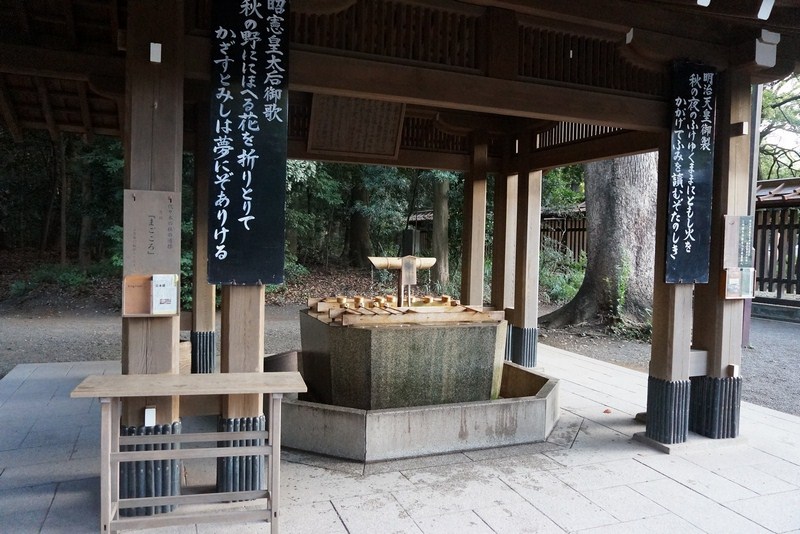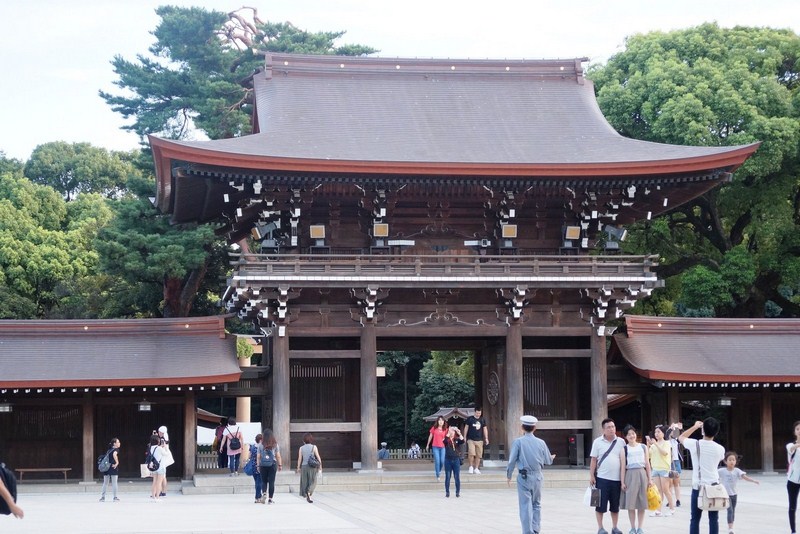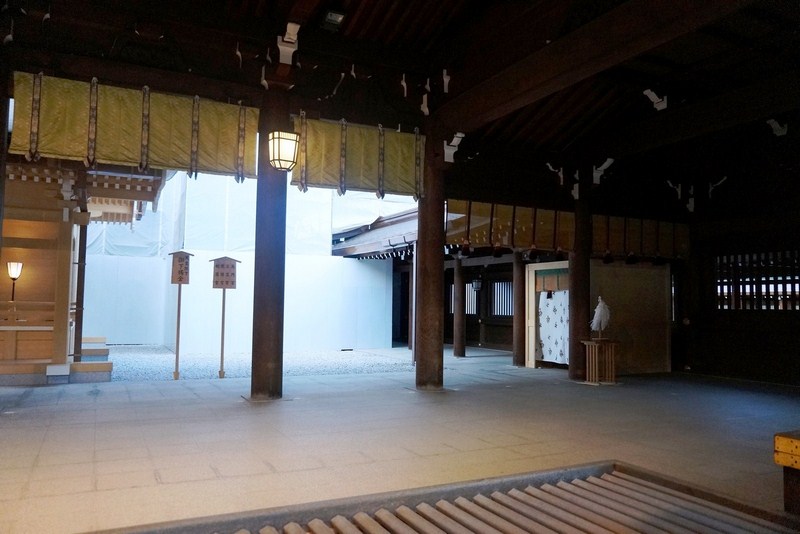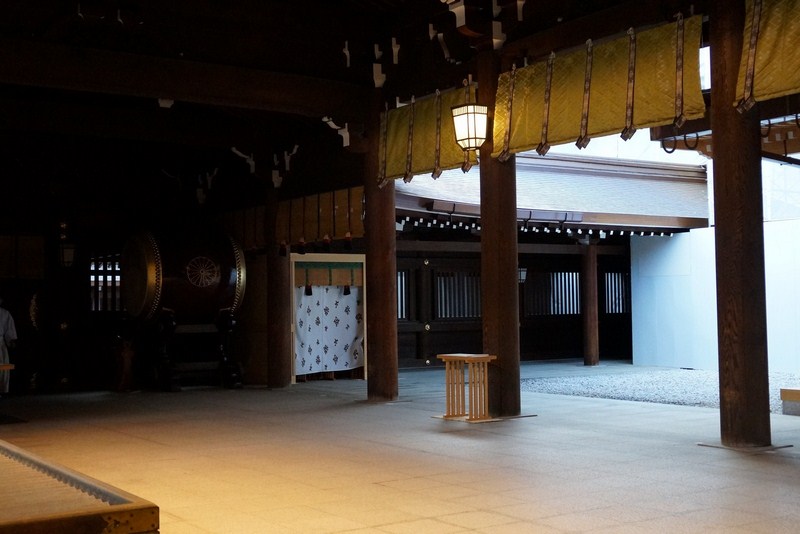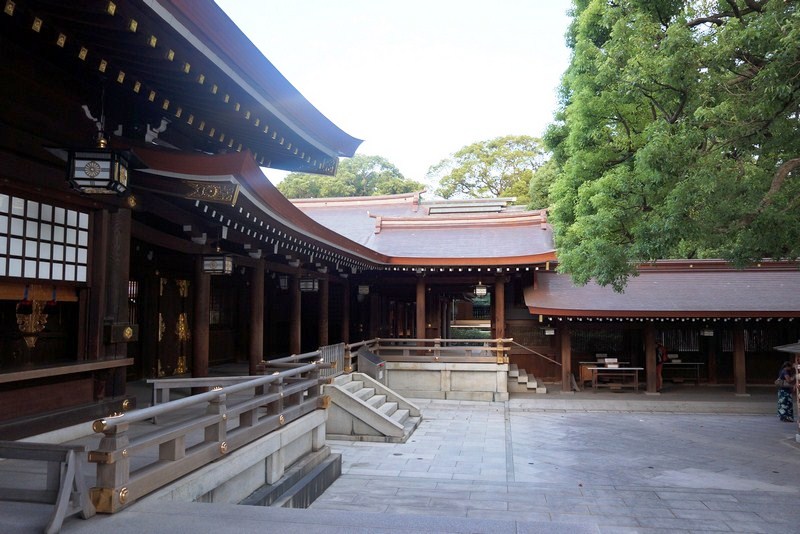As we delved deeper into Yoyogi Park, we soon came across the entrance to the Meiji Shrine. Located directly in front of the entrance to the shrine was the temizuya (font), a cleansing station where visitors used wooden ladles to spiritually cleanse themselves by pouring water over their hands (left before right) and rinse mouths with their left hand.
The Meiji Shrine (明治神宮 Meiji Jingū), the largest and one of the Japan’s most popular Shinto shrines, is dedicated to the deified spirits of Emperor Meiji (the shrine, however, does not contain the emperor’s grave, which is located at Fushimi-momoyama, south of Kyoto) and his wife and consort, Empress Shōken.

Torii (Japanese gate) at the entrance of the Meiji Jingu Shrine. Devotees usually bow once here upon entering and exiting the shrine.
After the emperor’s death in 1912, the Japanese Diet passed a resolution to commemorate his role in the Meiji Restoration, choosing an iris garden, in an area of Tokyo where Emperor Meiji and Empress Shōken had been known to visit, as the building’s location. The building of the shrine, a national project, mobilized youth groups and other civic associations from throughout Japan, who contributed labor and funding. In 1915, construction began under Itō Chūta.
The shrine, built in the traditional nagare-zukuri style, primarily uses Japanese cypress and copper. On November 1, 1920, eight years after the passing of the emperor and six years after the passing of the empress, it was formally dedicated and completed in 1921. Its grounds were officially finished by 1926. Until 1946, the Meiji Shrine was officially designated one of the Kanpei-taisha (官幣大社), meaning that it stood in the first rank of government supported shrines.
During the Tokyo air raids of World War II, the original building was destroyed and the present iteration of the shrine was funded through a public fund raising effort and completed in October 1958. The shrine has been visited by numerous foreign politicians, including U.S. Pres. George W. Bush, U.S. Secretary of State Hillary Clinton, and German Foreign Minister Guido Westerwelle.
The entrance to the shrine complex, marked by a massive torii gate (one of the largest in Japan) in the Myojin style, constructed from a more than 1,500 year old hinoki (Japanese cypress from Taiwan), leads through the Jingu Bashi bridge. Upon entry into the shrine grounds, the sights and sounds of the busy city are replaced by a tranquil forest and Meiji Jingu’s buildings, at the middle of the forest, that have an air of tranquility distinct from the surrounding city.
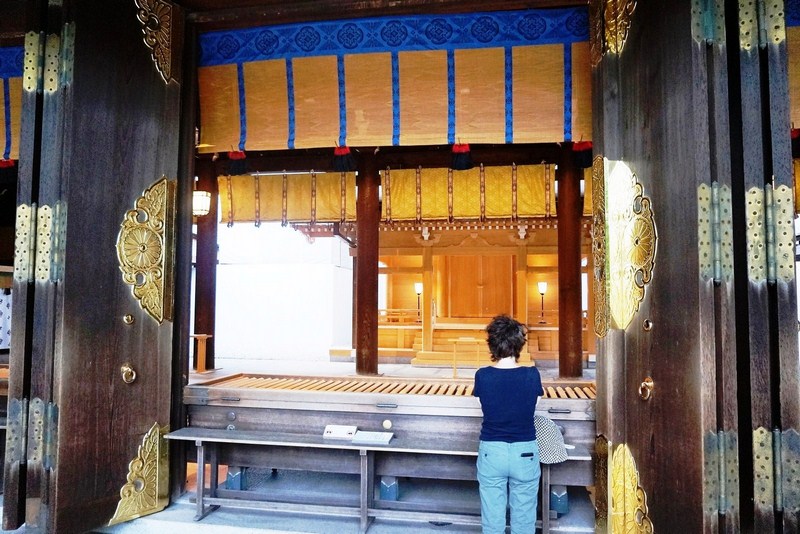
A lady worshiper praying at the Main Hall. In front of her is an offertory box where coins are dropped
Visitors to the shrine can take part in typical Shinto activities – making offerings at the main hall, buying charms and amulets, writing out one’s wish on an ema (piece of paper) and tying them on a prayer wall, etc. On the first days of the New Year, Japanese usually visit a Shinto shrine to prepare for the Hatsumōde (初詣), the year’s first prayers, and the shrine is the most popular location in Tokyo for this, regularly welcoming more than three million visitors. During the rest of the year, traditional Shinto weddings can often be seen taking place there.

Visitors shopping for omamori (lucky charms, talismans and amulets for all kinds of occasions) or ofuda (emblems bearing the name of the shrine or enshrined deities distributed by the shrine)
The shrine itself is composed of two major areas – the Naien and the Gaien. The Naien, the inner precinct, is centered on the shrine buildings, dating from 1958. The buildings, all great example of Japanese Shinto architecture, are made from Japanese cypress wood from the Kiso region of Nagano (regarded as the best in Japan) with green cooper plates used for the roofs.
It consists of the honden (The Main Hall, the main shrine building proper and the innermost sanctuary of the shrine), noritoden (The Prayer Recital Hall where Shinto liturgy is recited), naihaiden (The Inner Shrine Hall), gehaiden (The Outer Shrine Hall), shinsenjo (the consecrated kitchen for the preparation of the food offerings) and shinko (The Treasure House).
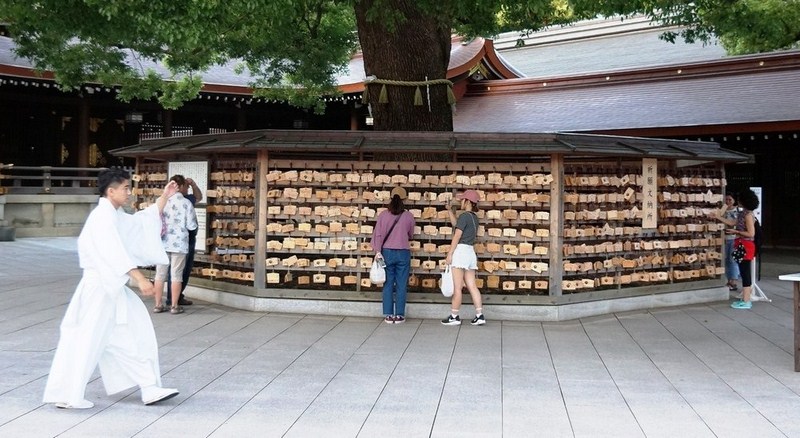
A prayer wall where ema are hung on hooks. An ema is a wooden tablet, obtained at the juyosho (amulet offices), where wishes are written. There are two main types of ema – Kigan-Ema (bear the crest of the shrine on their front and the word Kigan on their back) and the Eto-Ema (depicting this year’s Eto or zodiac).
The Treasure House, at the northern end of the shrine grounds, was built in the Azekurazukuri style one year after the shrine was opened. It displays many interesting personal belongings of the Emperor and Empress, including the carriage which the emperor rode to the formal declaration of the Meiji Constitution in 1889. The Museum Annex Building, just to the east of the main shrine buildings, displays temporary exhibitions.
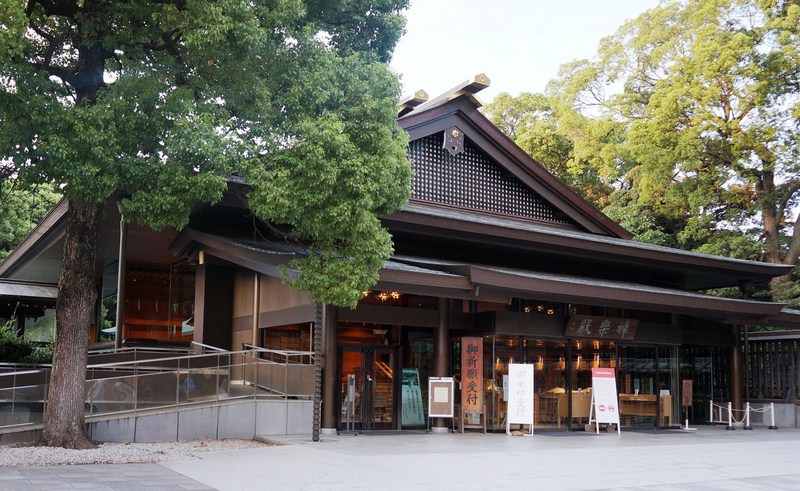
Kaguraden (Hall of Shinto Music and Dance). Goshuin (Meiji Jingu Memorial Seal), to remind you of your visit to Meiji Jingu, are stamped and hand-painted here.
The quite beautiful, simple and classic Minami-shin Mon, the main shrine gate to the inner precinct, was built in 1921. Made entirely of Japanese cypress, it has a copper plate roof. You reach it upon passing the final myojin torii gate. This gate and one of the amulet offices (shukueisha) were the only constructions in Meiji Shrine not destroyed by the World War II raids.
The Kaguraden (Hall of Shinto Music and Dance), built to commemorate the 70th anniversary of the establishment of Meiji Jingu, was started in 1990 and completed in October 1993. This 3-storey building (one floor is above the ground and the other two floors below ground level) follows the traditional Irimoya-Nagarezukuri architectural style The front entrance, with the reception and registration area, is slightly below ground level. One flight of stairs leads down, and another flight of stairs leads up to the waiting area and the hall for ceremonies.
The Gaien, the outer precinct, includes the Meiji Memorial Picture Gallery (housing a collection of 80 large murals illustrative of the events in the lives of the Emperor and his consort); a variety of sports facilities, including the National Stadium (Meiji Jingu Gaien Stadium and later, since 1956, on the same site, Tokyo Olympic Stadium); the Meiji Kinenkan (Meiji Memorial Hall). The latter, originally used for governmental meetings (including discussions surrounding the drafting of the Meiji Constitution in the late 19th century), is now used for Shinto weddings as well as meeting rooms for rent and restaurants services.
The Meiji-jingu Gyoen (Inner Garden), a large area of the southern section of the shrine grounds, becomes particularly popular during the middle of June when the beautiful irises here are in bloom. Kiyomasa’s Well, a small well located within the garden visited by the Emperor and Empress while they were alive, was named after a military commander who dug it around 400 years ago. The well has become a popular spiritual “power spot.”
Meiji Shrine: 1-1, Kamizono-chō, Yoyogi, Shibuya-ku, Tokyo 151-0053. Open daily, from sunrise to sunset. Admission to the shrine precinct is free. The Inner Garden, open from 9 AM to 5 PM, requires an entrance fee of JP¥500 to enter.
How to Get There: From JR Tokyo Station, get on the Yamanote Line and get off at the busy Harajuku Station on the JR Yamanote Line or Meiji-jingu-mae Station on the Chiyoda and Fukutoshin Subway Lines. It is about a 25 minute train ride. The approach to Meiji Shrine starts a few steps from Harajuku Station. The main complex of shrine buildings is a 10-min. walk from both the southern entrance near Harajuku Station and the northern entrance near Yoyogi Station.

